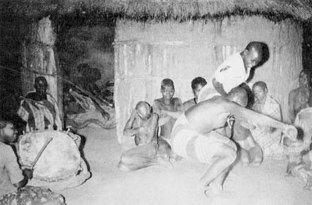
Novices practice ndayo outside the council hut at vhusha.
|
|
| Vhusha was the first phase in Venda girls' initiation. Strictly speaking, girls should have attended vhusha as soon as possible after their first menses, and then tshikanda and domba shortly before they were married. Vhusha could be held several times a year in the head-quarters of any district headman, but tshikanda and domba were held only at intervals of three to five years at the head-quarters of chiefs and certain senior headman, and for girls of several districts. Unlike domba and tshikanda, there were separate vhusha schools for noble and commoner girls. At vhusha Venda girls were introduced to the milayo (laws or esoteric knowledge), which were meant to prepare them for their future roles as wives and mothers. While vhusha for commoner girls involved considerable musical performance, there was no music at vhusha for girls of noble birth. However, the songs and dance exercises of vhusha (ndayo) were also used in tshikanda, where noble girls had an opportunity to learn them.
Novices practice ndayo outside the council hut at vhusha.
|